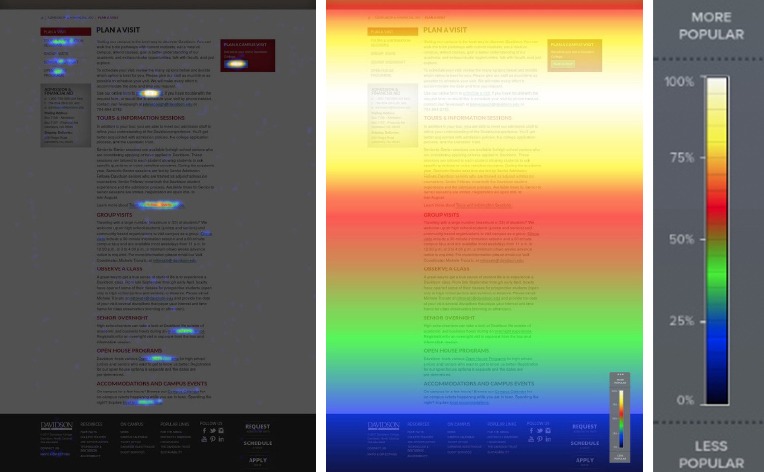Writing for the Web
How It’s Different
The first and most important fact to understand about web use is, people don’t read web pages, people scan web pages.
Web usability gurus, John Morkes and Jakob Nielsen, found that 79 percent of test users always scanned any new page they came across, while only 16 percent read word-by-word.
Web users scan the page, searching for:
- Headings
- Keywords
- Links or calls to action
- Bulleted lists

Scroll Map and Heat Map, 2018 Davidson.edu Research & Discovery
Writing Efficiently for Audiences
Write from the perspective of you reader. Think of them as busy, impatient people who are on the web to find out something quickly.
- Start with the conclusion (the inverted pyramid method)
- Avoid long introductory paragraphs
- Use meaningful subheadings to aid scanning and SEO
- Keep sentences brief
- Use clear, concise language
- Use active voice
- Write in the first or second person
- Chunk ideas into short paragraphs
- Use bulleted and/or numbered lists
Most importantly, halve the amount of content. Your content must be optimized for the way people navigate the web — it should have half the word count (or less) of the same piece written for print. Try writing the text the way you would normally write it, then cutting out everything you can. Give yourself some time and come back to it, and edit yet again.
Choose Content Wisely
Visitors are in control on the web. They’re short on time and can access billions of pages at the click of a mouse, so they’re very selective in what they choose to read.
Approach your content selection by asking yourself:
- Is this as clear as possible?
- Is there a simpler way to say this?
- Is there a shorter way to say this?
- Is this absolutely necessary?
Don’t fall into the trap of thinking it won’t hurt to publish any content you have. Content isn’t neutral. It either delivers value or destroys it. If you bore users or waste their time, they leave the site with a negative reaction.
Be Task-Oriented
Write With a Visitor-Centered Focus
When choosing content, keep in mind what tasks visitors want to accomplish on your site. Choose the content they need to accomplish their tasks, and organize it to help them finish their tasks quickly and easily. It’s difficult to break away from an organization-centered focus and move to a visitor-centered focus, but it’s vital to creating successful content.
One technique that may help as your write content for the web is for you to develop a list of questions that the particular audience for that page would ask, if they were there in person. Then let those questions guide what content goes on the page.
Above all, focus on what your visitors need to do, not on what you think you need to tell them.
Word Count Guidelines
- Headings and subheads: up to 3-5 words on a single line
- Sentences: up to 20 words
- Paragraphs: up to 70 words
- Pages: up to 600 words
Don’t duplicate any information that exists on other pages, instead just link to the page.
Additional Resources
- LinkedIn Learning: take the free online course, Learning to Write for the Web
- Email digitalstaff@davidson.edu for assistance in editing your content for the web.
